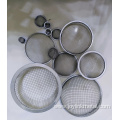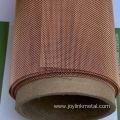Core Specification Parameters
1.Material Selection
304: A general-purpose austenitic stainless steel with a chromium content of ≥18% and nickel content of ≥8%. It has good acid-alkali resistance and oxidation resistance, with a tensile strength of 500-1000MPa. It meets the food-grade GB 4806.9 standard and is suitable for most conventional filtration scenarios.
316: Molybdenum is added to the 304 base material, significantly enhancing its resistance to chloride ion corrosion. It is suitable for highly corrosive environments such as marine and chemical industries.
316L: An ultra-low carbon grade with excellent welding performance, which can avoid intergranular corrosion after welding. It is suitable for high-temperature welding scenarios and harsh corrosive environments.
430: A martensitic stainless steel with good oxidation resistance, high strength and low cost. It is suitable for decorative or protective scenarios with mild corrosion.
2205: A duplex stainless steel with both high strength and high corrosion resistance, used in high-end protection needs such as chemical and oil-gas pipelines.
2.Weaving and Precision Parameters
plain Weave: Warp and weft threads are interlaced, with a uniform structure, an open area of 30%-50%, and a filtration precision of 0.05-5mm. It is a general-purpose weaving method.
Twill Weave: Warp and weft threads are staggered and overlapped, featuring stronger flexibility and wear resistance. It has an open area of 20%-40% and a filtration precision of 0.02-3mm. For example, a 90-mesh twill mesh usually has a wire diameter of 0.11mm and an aperture of 0.175mm.
Dutch Weave (Twill Dutch Weave): It has a dense structure with thick weft threads, enabling micron-level filtration of 1-100μm. The plain Dutch weave ranges from 12x64 to 50x250 meshes, and the twill Dutch weave can reach 24x220 to 400x2800 meshes, suitable for high-precision filtration needs.
Wire Diameter: 0.05-6mm. Fine wires are used for precision filtration, while thick wires are suitable for heavy-duty screening scenarios.
Mesh Count and Aperture: 10-635 meshes are available. The higher the mesh count, the smaller the aperture (e.g., 10 meshes have an aperture of approximately 2mm, and 635 meshes have an aperture of approximately 0.02mm), complying with the ISO 9044 industrial screen aperture classification standard.
External Dimensions: Regular widths are 1m, 1.22m, and 1.5m; lengths of 10m, 15m, and 20m can be customized. Special forms include filter mesh belts for extruders with a width of 100mm-1200mm and a length of 10m-30m. It can also be processed into flat, cylindrical, corrugated, and multi-layer composite types.
3.Core Performance Indicators
Corrosion Resistance: 316L > 316 > 304 > 430, which can withstand different corrosive environments such as acid, alkali, and salt spray.
High-Temperature Resistance: Austenitic stainless steel can work stably in environments below 800℃ for a long time.
Easy Cleanliness: The smooth surface is not easy to adhere to impurities, meeting the cleanliness requirements of the food, pharmaceutical, and other industries.
Main Application Scenarios
1.Industrial Production Filtration
Petrochemical Industry: 316L Dutch weave is used to make pipeline filters and catalyst carriers, or as the inner lining protective mesh of reaction kettles to filter particulate impurities in crude oil and chemical media and resist the erosion of corrosive media.
Plastic Pelletizing and Extrusion: 304 material with 20-120 meshes is used to filter molten plastics such as PP and PE, removing unmelted particles and impurities to ensure the purity of finished products. In the extrusion blow molding process, high-mesh filters are used to prevent spots and holes on the film.
Rubber Processing: Before mixing, medium-mesh (40-80 meshes) filters are used to trap sediment and metal debris in natural rubber or synthetic rubber, improving the elasticity and service life of products.
Mining Screening: 10-100 medium-mesh filters are used for ore particle classification to separate minerals of different particle sizes, suitable for roughing and cleaning processes.
2.Food and Pharmaceutical Fields
Food Processing: 304 material with 20-200 meshes is used for juice filtration and sauce screening. The ventilation mesh of fermentation tanks ensures sterile ventilation, and the conveyor belt support mesh meets the cleanliness requirements of food transportation.
Pharmaceutical Production: 200-500 high-precision meshes are used for liquid medicine purification and powder screening to prevent impurities from affecting the purity of pharmaceuticals, complying with the cleanliness standards of the pharmaceutical industry.
3.Environmental Protection and Water Treatment
Sewage Treatment: 10-50 meshes are used for pre-treatment to filter suspended particles in sewage. In the seawater desalination process, 316L filters are used for preliminary impurity filtration to improve the efficiency of subsequent treatment.
Water Purification Equipment: 304 activated carbon composite filters are used in household/industrial water purifiers to filter sediment and rust, and 316L precision filters are used for deep purification.
4.Protection and Other Scenarios
Mechanical Protection: Low-mesh thick-wire filters made of 430 material are used to make equipment protective covers and machine tool protective nets, with both strength and oxidation resistance.
Automotive Manufacturing: 304 material filters are used for heat insulation of the exhaust system and support of battery electrode plates, withstanding high temperatures and electrolyte corrosion.
Architectural Decoration: 430 or 304 material filters are processed into curtain wall light-transmitting nets and stair handrail protective nets, taking into account both aesthetics and protection functions.




























